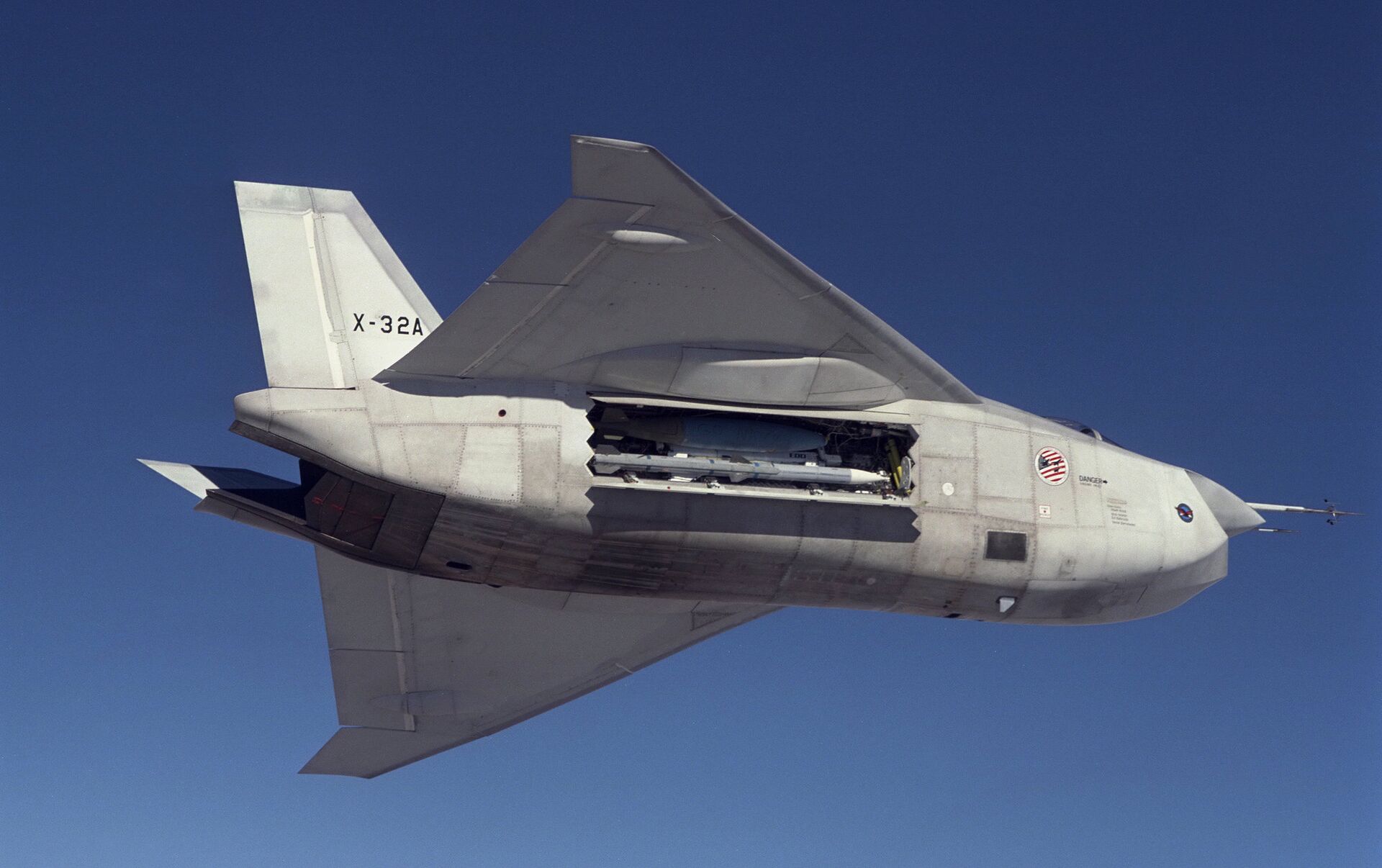X 32 Boeing - The X-32 certainly has some amazing features. Why did the US military choose the F-35 instead? The Boeing X-32 was a multirole jet fighter designed for the Joint Strike Fighter competition, but lost out to Lockheed Martin's X-35 demonstrator, which later developed into the Lockheed Martin F-35 Lightning II.
Lesser known is that Boeing assembled two proof-of-concept aircraft, the X-32A and X-32B, which made its first flight in September 2000. A total of 66 flights were conducted during the four months of intensive testing, which also demonstrated aerial refueling, weapons bay operation and supersonic flight capabilities.
X 32 Boeing

The X-32B, on the other hand, premiered in March 2001 and eventually completed nearly eighty test flights in four months.
Laughter From The Skies: The Boeing X 32
According to Aviation Geek Club, "The aircraft successfully entered and exited STOVL flight mode using a direct lift system to redirect thrust from the aircraft's cruise nozzle to the lift nozzle. The X-32B demonstrated the ability to hover and vertically land .
With this in mind, one of the most popular questions today is whether the Boeing X-32 is more advanced than the Lockheed Martin X-35.
David Tussey, a former U.S. Navy pilot, recently wrote on Quora: "It is worth noting that the X-32 entered the race about a month before the X-35. It was ready to take off and clearly had an early lead.
He lists some of the ways in which the Boeing X-32 is superior to the Lockheed Martin X-35. "Probably cheaper. The X-32 uses a less complex design and more manufacturing methods. The proposed final design differs from the prototype and is more conventional (one-off delta wings are discarded)," Tussi argued.
Boeing X32 A Jsf
"More survivable in war. Maybe, again, due to the complex design. Maybe it can be expanded more over time. I think Lockheed's design is a bit rigid, but that's mostly speculation," he continued.
Tussey then concluded: “One can only imagine what the design would have looked like had the STOVL requirement been omitted. Once the Lockheed thrust fan was proven to work, the competition was pretty much over.
Aviation expert David Rendell said on the same website that the Boeing F-32 has some advantages but suffers from similar problems as the Lightning II.

"Boeing didn't fully understand the naval aspect of carrier landing control so they had to start over after finishing the X-32. This was a huge mistake on their part and one of the reasons they lost the contract, the X-35 was very close to the final product ,"He said.
Boeing X 32: The F 32 That Never Happened...
"Most of the problems with the F-35 come from the new avionics, coding issues, and maintenance of the stealth outer coating. These will be the same systems and materials used in the F-32, so apart from needing to spend a few more years in the wind tunnel Plus, there will be many of the same delays and issues," he continued.
Ethan Kim Leeser is a tech editor in Washington State who has worked at Google, The Korea Herald, The Lincoln Star, Asia Week, and Arirang TV. follow or contact him
Ethan Kim is a tech editor in Washington State who has worked at Google, The Korea Herald, The Lincoln Star, Asia Week, and Arirang TV. It was defeated by the Lockheed Martin X-35 demonstrator, which later developed into the Lockheed Martin F-35 Lightning II.
This part needs more references to confirm. Please help improve this article by adding citations to reliable sources. Unverifiable content may be challenged for removal. (January 2019) (Learn how and how to remove this template message)
Meet The Boeing X 32 Stealth Fighter: It Could Have Replaced The F 35
The purpose of the program is to develop a stealthy design to replace the U.S. Department of Defense's light fighter and attack aircraft, including the F-16 Fighting Falcon and McDonnell Douglas F/A-18 Hornet, vertical/short takeoff/.vertical landing (V/STOL) AV-8B Harrier II.
In 1994, Congress authorized the merger of the two into the Joint Strike Fighter (JSF) program.
Several companies are involved in the first phase of the project, which involves drafting a conceptual aircraft design for submission to the Department of Defense. On November 16, 1996, Boeing and Lockheed Martin were awarded contracts to each build two proof-of-concept aircraft (CDAs).

According to the contract, these fighters need to perform conventional take-off and landing (CTOL), carrier-based take-off and landing (CV version) and short take-off and landing vertical take-off and landing (STOVL) demonstrations. They are also expected to include ground demonstrations of production representative aircraft systems, such as the Preferred Weapon System Concept (PWSC).
Boeing X 32 Which Lost To The Joint Strike Fighter Contest To Lockheed Martin F 35 Lightning Ii
A major difference from previous projects is that companies are prohibited from using their own money to finance development. Each company received $750 million to build their two planes, including avionics, software and hardware. This restriction encourages the adoption of low-cost manufacturing and assembly techniques and prevents Boeing or Lockheed Martin from going bankrupt.
Boeing's competitive advantage strategy is to significantly reduce manufacturing and life cycle costs by reducing variance between different JSF versions. So the X-32 is designed around a large one-piece carbon fiber composite delta wing. The wings are 9.15 meters long and have a leading edge sweep of 55 degrees, and can carry up to 20,000 pounds (9,000 kilograms) of fuel. The purpose of the high sweep angle is to allow the use of thicker wing sections while providing limited transonic aerodynamic drag and providing good angles for wing-mounted conformal antenna setups.
A cost-competitive strategy led Boeing to choose a direct-lift thrust-vectoring system to meet the Marine Corps' short take-off and vertical landing (STOVL) requirements because it required adding a thrust-vectoring module around it. Mainly Jainism.
However, this option required mounting the jib directly behind the cockpit and achieved a neutral attitude hover by moving the gravity sector forward from its normal position on a jet fighter (toward the rear of the aircraft). Boeing proposed a similar supersonic fighter in the 1960s with a mid-course gravity mount gain and a thrust-vectoring nozzle, but it didn't go beyond the pictures published in Aviation Week.
An Artist?s Impression Of The Boeing Entry In The Joint Strike Fighter (jsf) Competition, Stock Photo, Picture And Rights Managed Image. Pic. Mev 12024120
By comparison, Lockheed's effort looks like a scaled-down version of the F-22 Raptor stealth fighter.
Another effect of opting for a drop-lift system is the large chin-mounted air intake. This is necessary to supply enough air to the main boom (to provide enough thrust to hover) during the zero horizontal velocity phase where ram air pressure cannot be utilized. A knock-on effect of this high intake volume is the direct radar visibility of the compressor blades (see radar cross-section). Mitigation options include variable baffles designed to block incoming radio waves without adversely affecting airflow.
The two X-32s were designed by Delta Wing. However, eight months after the proof-of-concept was built, Boeing's delta-wing design fell short of its new goals after modifications were made to the JSF's maneuverability and payload requirements at the request of the Navy. The Guineans modified the plane's design to use a traditional sloping twin tail to reduce weight and improve maneuverability, but it was too late to change the plane. They were considered good enough to showcase Boeing's technology.

On December 14, 1999, Boeing unveiled two concept demonstrators in front of 5,500 members at its Palmdale, California, factory. Although the X-32A was expected, the role of the X-32B was surprising, as the second aircraft was built about three months after the first and completed six weeks after the X-32A.
Italeri Boeing Jsf Plastic Scale Model 1/72
Boeing was responsible for rapid production of the STOVL version using digital design and assembly methods.
After installing the Pratt & Whitney F119 Gin in April 2000, the X-32A began low and medium speed taxi tests and completed them in late May.
Due to the X-32's heavy delta wing design, Boeing demonstrated STOVL and supersonic flight in separate configurations, the STOVL configuration requiring certain components to be removed from the fighter. The company promises that the traditional rear wing design they use for production models requires no special configuration. In contrast, Lockheed Martin's X-35 proof-of-concept aircraft is capable of switching between STOVL and supersonic configurations mid-flight.
The first flight of the X-32A (designed for CTOL and carrier testing) took place on September 18, 2000, from Boeing's Palmdale facility to Edwards Air Force Base. Piloted by Boeing test pilot Fred Knox, the plane ran the 2,200-foot (670-meter) runway before blasting off at 150 knots (280 kilometers; 170 miles) around 8 p.m. ET.
Boeing X 32a By Bagera3005 On Deviantart
Shortly after takeoff, a small hydraulic leak was detected and the flight time was shortened from the expected 30-40 minutes to 20 minutes.
According to Knox, the F/A-18 chase aircraft needed "a lot of afterburner" to keep up with the X-32 early on. In flight, the aircraft is at 10,000 feet (3,000 meters),
Boeing x-32, boeing c 32 interior, 32 x 84 door, boeing c-32, boeing p 32, boeing x 32 jsf, boeing f 32, 24 x 32 frame, boeing x 32 vs f 35, 32 x 36 mirror, 60 x 32 bathtub, 72 x 32 bathtub
0 Comments